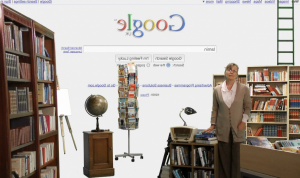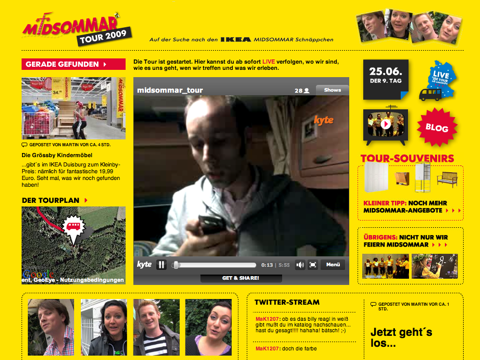von Roland Hachmann | Feb 3, 2010 | Ad News, Blog, Digital Marketing, Marketing, Online Advertising
I am badly hooked on the series „lost„, as I wrote in my German Blog already. The sixth and supposedly last season started yesterday in the US (the parts are available in Germany always one day later), however in the last couple of days / weeks a few marketing gigs have already taken place. Such as this one: you can book a flight on Oceanic 815 from Sydney to L.A. on kayak.com – for a horrendous price, of course. Quite a nice idea!

(via adverlab)
von Roland Hachmann | Nov 21, 2009 | Blog, Digital Marketing, Online Advertising, SEO / SEA
Coming up for an original idea for a rather ordinary product like the cereal wheetabix isn’t always easy.
In this case, it’s a play on the fact that wheetabix as a breakfast gives you energy for the whole day. So they came up with a questions that is interesting for all of us: „What makes the worlds largest search engine work?“

The answer: a library lady who assembles all the information within 0.12 seconds (or so), you can take a peak behind the Google screen over here.
When you’re not typing search queries yourself, it seems like you can see queries of other people as live search. But somehow I don’t believe that…
von Roland Hachmann | Jun 25, 2009 | Blog, Digital Marketing, Online Advertising, Social Media Marketing
Martin, Sarah, Julian and Cornelia are cruising from on Ikea to the next all throughout Germany as part of an Ikea Midsommar Tour, in order to find the best Midsommar bargains in Germany.

The whole journey is being documented in many (partially live) video shows, blogs of each of the four and a Google map where you can check on their current position. Of course, the four travellers also have twitter profiles.
What I find puzzling is the fact that the blogs neither allow for comments, nor do they offer permalinks. Not really blog-like, if you ask me.
Quite well done is their strategy to reactivate people that were fans of a previous campaign they did almost a year ago: the main character of that campaign – Nils, who back then was „waiting for September“ – started his Twitterfeed again, in order to point users who did not unfollow in the meantime (like yours truly) to the campaign.
The only thing that concerns me: it reminds me somehow of the Fake Walmart Blogger in 2006. Mind you, they do not conceil the fact that this is a campaign for Ikea, so you can’t really compare it…
von Roland Hachmann | Jun 13, 2009 | Ad News, Blog, Digital Marketing, Marketing, Online Advertising, Social Media Marketing
14:00 audience session: context by Stefan Erschwendner
Some interesting questions arise after the kick off presentation:
- Should agencies rather focus on context of the target audience? Will context drive marketing (communicationss) in the future?
- Which type of agency will be best suited for this in the future? PR or ad agencies?
- What happens when companies piggyback contexts without honestly solving the problems relevant to these contexts – when the branding effect is purely placebo.
- How can you focus on certain contexts, for chocolate bars, for example? You can’t with the current system of target audience definition.
- If the goal is managing relationships with consumers in different contexts, who will do that in the future? The brand, the agency? Probably the brand in the long term, agencies will turn in to coaches.
- Will the time frame for communications programms change? The model of having „quarterly“ campaigns can probably not be sustained in the future.
von Roland Hachmann | Jun 13, 2009 | Ad News, Blog, Digital Marketing, Marketing, Online Advertising, Social Media Marketing
11:05 second day just started, with some delay, as Roland points out explicitly 😉
First panel:
Trend Cocooning
Wie verändert die Krise das Verbraucherverhalten?
With Prof. Peter Wippermann and Roland Kühl v. Puttkammer (Organisator der remix09)
- First, Roland explains the trend cocooning. Prof. Wippermann expands on it. The trend was orifinally coined by Faith Popcorn, before the internet existed in it’s current version.
- Quote Wippermann: Freedom is being defined by technology…
- Prof. Wippermann about scouting the web via software for identifying trends and topics. Sounds reasonable.
- The below 20 year olds search for social connections preferrably online, instead of online. (?)
- Now the panel is extended by two people from the audience: a young guy living in London, and John Groves, one of the sponsors of the conference. They are now discussing their personal media usage.
- Especially younger people don’t have an internet presence such as a „homepage“, but rather facebook profiles, etc. Homepages are oldschool?
- Wippermann: „Die Mitte ist die neue Minderheit“ (not sure how to translate that: the average German is a minority)
- People in gerneral are very slow in adopting new things. 34% still calculate prices in Deutsche Mark.
- Who has more knowledge about the consumer: the ad agency or the companies? Wippermann: the companies. Agencies are still busy being „creative“.
- it is an idea of the industrial age to separate everything: ad agencies from the companies. Originally, advertising was part of the companies. In the network age, everything will be connected (again).
- The middlemen (media companies, agencies) will have to proof their added value. Companies can directly connect with their target audience and gain knowledge.
- Three Trends by Wipperman: freedom defined by technology, success defined by sharing, family as a „negative“ trend, because people are afraid/don’t want it…
12:00 – next session is about Hinz&Kunzt, a street magazine sold by homeless people here in Hamburg.
Hinz & Kunzt
Ein gemeinnütziger Verlag im Überblick
- A monthly magazine, founded: 1993 by Dr. Reimers. A brand awareness of 94% The idea: helping people to help themselves. Financially and politically independent.
- Each homeless person is a single entrepreneur. They purchase the magazine in advance for 0,80€ and then sell it for 1,70€ When starting, each reseller gets 10 magazines for free. There are about 400 resellers in Hamburg.
- There also is a website, wich some of the magazine articles as a teaser. They even have a blog (because: you have to have one today…?)
von Roland Hachmann | Jun 12, 2009 | Ad News, Blog, Digital Marketing, Online Advertising, Social Media Marketing
17:33h – Ok, I skipped a session: quantitative vs qualitative viral marketing by viral seeding company elbkind. Very interesting session with a goood discussion about reach of campaigns in generell (i.e. millions of views) vs reach within a certain target group (wich might result in viewer, but qualitatively lesser views).
Now I am sitting in this (last) session:
Agenturgezwitscher: Twittern zwischen Tratsch 2.0 und echtem Mehrwert
Bastian Scherbeck and Nicole Simon about twitter for agencies.
- One opportunity: internal communication instead of mail and IMs: it can reduce mail but doesn’t offer all functionalities needed.
- External Communications for clients: it’s all about transparency and trust. The agency needs empowerment when doing this, clients need „courage“.
- (missed the third scenario, as I had to answer an email for work)
- Interesting question from the audience: why should companies twitter? Answer: It depends. And: you can, you don’t have to.
- A further discussion with lots of questions from the audience arose about why should you twitter, personal accounts vs corporate accounts, etc. Temporarily it was stated that you can do customer service well (not cheaper) – in the future I believe that. Currently twitter has around 60-80.000 users in Germany. That’s a bit small to be a relevant channel for customer service…




 Wo ich sonst so bin...
Wo ich sonst so bin...